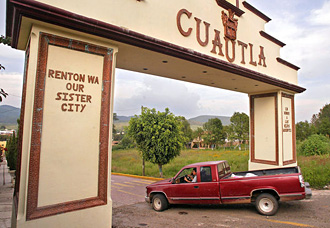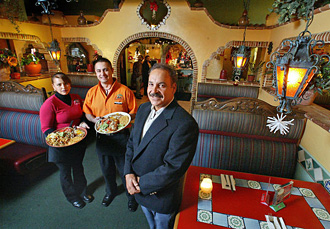 |
 |
 |
 Entertainment | Restaurants & Dining | December 2007 Entertainment | Restaurants & Dining | December 2007  
The Tacoma-Cuautla Connection
 Rob Carson - The Tacoma News Tribune Rob Carson - The Tacoma News Tribune
go to original


| | An arch leading into Cuautla proclaims the town’s connection to the Puget Sound area. Hundreds of natives have come north to labor long and hard as dishwashers, waiters and cooks – and, eventually for many, as restaurant owners and operators. (Drew Perine/The News Tribune) | 
| | Ruben Arias came to the United States at age 18 from tiny Cuautla, Mexico, in 1970 with $4 in his pocket. Now he owns five El Toro restaurants, including this one in Parkland. He worked 364 days his first year. Staff members Leticia Sigala and Rene Gonzalez are from Guadalajara, Mexico. (Drew Perine/The News Tribune) |
Check out the pictures on the walls at Mis Tres Amigos Mexican restaurant in Lakewood and you’ll find a small, faded photograph of a little Mexican town, nestled in green hills.

The town is pretty but seems unremarkable. In fact, it’s extraordinary.

The town is Cuautla, a remote mountain community of about 1,000 people located midway between Guadalajara and the resort city of Puerto Vallarta.

What’s remarkable about Cuautla is that its residents own and operate more than 300 Mexican restaurants in Washington state, including the Azteca, El Toro, Maya’s Moctezuma’s, Mazatlan and Tacos Guaymas chains.

Thanks to a voracious appetite in Washington for tacos, enchiladas and burritos, several Cuautla residents who sneaked into the United States in the 1970s with no money and no English now are driving Jaguars and flying private planes.

“For the people of Cuautla, Washington is a paradise of money,” said Pedro Gomez, a rancher and horse trainer who lives in the nearby town of Ayutla. “Everybody has restaurants there.”

Not quite. But there now are so many Mexican restaurants in Washington state that Cuautlan owners say the market is glutted. They’re competing more vigorously with each other than before and branching out across the country.

Almost to a person, the successful restaurateurs attribute their success to a young schoolteacher from Cuautla named Maria Luz Lara Lopez, who came to Seattle as a nanny in 1957 and built a chain of seven Mexican restaurants.

When Lopez’s first restaurant, Lucy’s, at Sixth Street and Pike Avenue in Seattle, began turning a profit in 1970, she sent word to her hometown that there was money to be made. That started a steady migratory stream from Cuautla to Washington that continues to this day.

Hundreds of Cuautlans have made their way north to work as dishwashers, waiters and cooks.

Many who graduated from Lopez’s kitchens started successful restaurants of their own. Among them are Andres Cardenes, founder of the Guadalajara chain, and Juan “Pepe” Ramos and his brothers, who started Azteca, now a chain of 35 restaurants that employs more than 1,400 people and serves more than 400,000 customers a month.

“That’s why we all are here,” said Ramon Fernandez, who owns the Mis Tres Amigos restaurants. “It is because of Lucy. The people came here and learned how.”

CROSSING THE BORDER

Fernandez left Cuautla for the United States in 1968, when he was 19. He began the trip with a 36-hour bus ride from Guadalajara to the U.S. border. He bought a forged passport in Tijuana, but it was such an obvious fake that the customs guards sent him packing.

“The picture did not look like me,” he said.

Fernandez worked at his uncle’s meat market in Tijuana until he got a legitimate work visa. He was allowed to cross into the United States to work, but no farther than 150 miles from the border. He took a job as a sandblaster at a Southern California foundry.

Other now-wealthy restaurateurs in the South Sound tell stories of riding across the border crammed in the trunks of cars, paying professional immigrant smugglers called “coyotes,” or climbing chain-link fences and dashing for cars waiting on the U.S. side.

In those pre-9/11 days, the borders were not so carefully guarded, said Lopez, now 79 and retired to her home in Seattle’s Green Lake neighborhood.

In her 30 years of running restaurants, hundreds of Cuautla natives came through her kitchens, she said, and almost none came legally. Yet, she said, immigration officials never once bothered her.

“At that time it was very easy,” Lopez said.

In the past, those who originally crossed the border illegally were able to get temporary work visas to stay in the States. Then, by virtue of their employment and length of residence, they were able to get green cards, giving them permanent resident status.

Since 9/11, the rules on immigration have grown much stricter. Illegal workers in Washington’s Mexican restaurants are now the exception rather than the rule, owners say.

THE OLD DAYS IN CUAUTLA

The Cuautla that the restaurateurs remember from their youths was an idyllic place in many ways, but desperately poor.

The countryside was beautiful, particularly in the rainy season, but there were no jobs other than working on wealthier neighbors’ farms and cattle ranches. Daily wages, when available, were less than what a single customer might leave for a tip at a restaurant in the States – 10 pesos, or about a dollar.

Lopez had a job as a teacher because her father was director of the tiny school system.

“I was one of the lucky ones,” she said. “For other young women there was nothing except working in the cornfields or being a maid.”

Fernandez’s father was a farmer and charro, or cowboy, like just about every other able-bodied man in town.

“People did everything,” he said, “whatever they had to.”

When he left Cuautla, Fernandez said, Lopez’s underground railroad to Washington hadn’t yet been established, but Cuautlans already had a tradition of leaving for jobs.

Because there was no work in Cuautla, it was common for men to leave for Mexico City or Guadalajara and send money home. After World War II many crossed the border to work in the fields in Arizona and California in the bracero program.

Ruben Arias, who now owns the local El Toro restaurants, got the urge to leave from Fernandez, his childhood friend.

“We wrote letters to each other,” Arias said. “In those days that was the only way to communicate. A couple of times he put a brand-new dollar bill in the envelope. That inspired me to come here.”

HARD WORK

Arias crossed the border on a legal visa in 1970 and went straight to San Mateo, Calif., where his cousin owned a Mexican restaurant. He was 18 and had $4 in his pocket. He worked as a dishwasher, cook, waiter and bartender, learning the business, saving his money.

In 1979, he’d saved enough to take advantage of an opportunity in Washington. Chester Espinoza, Lopez’s brother-in-law, was selling the El Toro restaurant, on Pacific Highway near Fort Lewis.

Arias drove to Tacoma, pulled into the El Toro parking lot and stashed his possessions in a little shack out back. He immediately went to work, beginning what turned out to be a solid year of 18-hour days. He ran El Toro almost single-handedly.

“I didn’t know anybody,” he said.

The first year Arias worked 364 days, closing the restaurant only once, on Christmas Day.

Arias could afford a waitress only during the busiest hours, at lunch and dinner. The rest of the time he was the cook, waiter and cashier, as well as the dishwasher and janitor.

To make customers think he had a more extensive operation, he sometimes pretended other staff members were in the kitchen, where, in fact, he was all by himself, racing around, grilling pork and beef, chopping onions and heating tortillas.

He kept two shirts on hand – one in the kitchen where he splattered grease and salsa and another clean one he slipped on to serve customers.

“I’d leave the radio playing in the kitchen to make it sound like there were more people back there,” he said. “Sometimes, I’d throw a spoon across to the other side of the room to make it sound like there was somebody working over there.”

Money was so tight the first year that he had trouble buying the produce he needed. He owned only 12 coffee cups. He remembers with embarrassment a day when a group of 20 soldiers came in all at once and he had to serve some coffee in glasses.

When customers left without paying, which occasionally happened, it was a near disaster. He still remembers the night a party of six soldiers ran up a big tab and then slipped out one by one, supposedly leaving the last man to pay.

The last GI went into the restroom, then dashed out when he thought Arias wasn’t looking. Arias ran after him but couldn’t catch him. That time and a few others, he said, he shed tears.

SUCCESS

Gradually, El Toro began turning enough of a profit so that Arias could pay a relative from Cuautla to come help him, sharing the space in the shack. Business continued to grow through the 1990s, for Arias and dozens of others from his hometown.

Ramos, the son of a grocer in Cuautla, started as a dishwasher in Seattle in 1973, speaking almost no English. For nearly two years he worked the night shift at Todd Shipyards in addition to his job at the restaurant.

He saved enough money to open his own 24-seat restaurant in Burien in 1974. With the profit he brought his mother and three brothers – Hector, Jaime and Victor – up from Cuautla. The Azteca chain of 35 restaurants now grosses millions.

In 1989, Arias had two restaurants and was doing well enough to help his old friend Fernandez into the business.

“I spent four years there from 1989 to 1993 working as a busboy, host, waiter, manager,” Fernandez said. “He taught me the business, and now I’m here.”

In 1993, Fernandez opened Mis Tres Amigos in Lakewood, then a second restaurant of the same name in Puyallup.

Arias now has five El Toro restaurants in the Tacoma area, plus a place called El Sarape in Olympia, which he owns with his brother, and a new restaurant in Utah. Arias is turning over his business to his sons. For relaxation, he rides his horses on trails through 240 acres of pasture and forest he owns near Yelm.

CROWDING AND COMPETITION

After decades of expansion, the Cuautlan entrepreneurs now say the field in Washington has grown too crowded. They have branched out across the country and are experimenting with business models to compete more effectively.

According to Arias, people from Cuautla have opened more than 1,000 restaurants in the United States. Most are in Washington, Oregon and Idaho, but a few are as far away as Florida.

Changing tastes and competition have led to new business models: one Cuautlan immigrant in particular, Salvador Sahagun, has succeeded with his Tacos Guaymas chain, which is based on a fast-food model of service and emphasizes fresh, healthy fare.

In the old days, the Cuautlan restaurant owners had an informal agreement not to locate new restaurants too close to established ones. That’s not the case anymore, Arias said. The tighter market has made for a colder, more competitive view, despite the hometown ties.

Sahagun has a saying that epitomizes the new attitude, Arias says:

“If you feel the heat, move.”

Rob Carson: rob.carson(at)thenewstribune.com | 
 | |
 |



